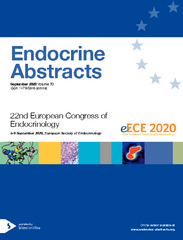Приказ основних података о документу
The effects of naringenin on NRF2 and antioxidant enzymes expressions in the thyroids of the old-aged Wistar rats
| dc.creator | Miler, Marko | |
| dc.creator | Živanović, Jasmina | |
| dc.creator | Ajdžanović, Vladimir | |
| dc.creator | Šošić-Jurjević, Branka | |
| dc.creator | Marković, Zorica | |
| dc.creator | Milošević, Verica | |
| dc.date.accessioned | 2021-02-03T12:11:26Z | |
| dc.date.available | 2021-02-03T12:11:26Z | |
| dc.date.issued | 2020 | |
| dc.identifier.issn | 1479-6848 | |
| dc.identifier.uri | https://www.endocrine-abstracts.org/ea/0070/abstract-book/ | |
| dc.identifier.uri | https://radar.ibiss.bg.ac.rs/handle/123456789/4110 | |
| dc.description.abstract | Citrus flavanone naringenin (NAR) is a potent antioxidant with ability to change pituitary-thyroid function. NAR increases concentration of thyroid- stimulating hormone (TSH) in serum by increasing Sirtuin1 expression in the pituitary thyrotrophs and improves thyroid hormonogenesis capacity in old-aged rats. Thyroid hormone production is followed by generation of large quantities of reactive oxygen species (ROS) which are essential for iodine organification. A master regulator of redox status, NRF2 protein, together with antioxidant enzymes (AOE), is responsible for maintenance of redox/antioxidant balance in the cell. Considering that NRF2 expression can be affected by NAR, besides TSH, the study aim is to analyze gene and protein expressions of NRF2 and AOE in the thyroids of 24-month-old male Wistar rats. NAR was suspended in sunflower oil (vehicle) and administrated directly to the oral cavity, at a dose of 15 mg/kg b.m., during 4 weeks. Control group received vehicle only. We performed qPCR and immunoblot analyses for gene and protein expressions, respectively. Obtained results showed that NAR treatment lowered (P < 0.05) mRNA levels of Nrf2, superoxide dismutase 1 and 2 (Sod1, Sod2) and catalase (Cat) for 42%, 32%, 45% and 35%, respectively, while it only increased (P < 0.05) expression of glutathione peroxidase (Gpx) for 54%, all in comparison with the controls. Gene expression of glutathione reductase (Gr) remained unchanged. Also, NAR up-regulated (P < 0.05) protein expression of NRF2 and SOD2 for 58% and 50%, respectively, and down-regulated (P < 0.05) SOD1 expression for 48%, all when compared to the adequate control values. CAT, GR and GPx protein expressions didn’t change after NAR treatment. It can be concluded that NAR changes gene and protein expression of NRF2 in old-aged rat model. Down-regulation in Nrf2 gene expression, and some AOE, is in line with previously observed TSH stimulation after NAR. Antioxidant protection in thyroid needs to be lowered in order to ensure sufficient ROS for adequate thyroid hormones production. However, due to NAR prooxidant properties, redox status in thyroid upon its application was changed, inducing accumulation of NRF2 protein in the thyrocytes. This led to increment of Gpx gene and SOD2 protein expression, helping in maintenance of fundamental antioxidant protection and disposal of excessive ROS in the thyroid gland of old-aged rats. | sr |
| dc.language.iso | en | sr |
| dc.publisher | European Society of Endocrinology | sr |
| dc.rights | openAccess | sr |
| dc.source | 22nd European Congress of Endocrinology; 2020 Sep 5-9 | sr |
| dc.title | The effects of naringenin on NRF2 and antioxidant enzymes expressions in the thyroids of the old-aged Wistar rats | sr |
| dc.type | conferenceObject | sr |
| dc.rights.license | ARR | sr |
| dcterms.abstract | Милошевић, Верица; Милер, Марко; Живановић, Јасмина; Aјджановић, Владимир; Шошић-Јурјевић, Бранка; Марковић, Зорица; | |
| dc.rights.holder | © 2020 by the European Society of Endocrinology | sr |
| dc.description.other | 22nd European Congress of Endocrinology: Abstracts; 2020 Sep 5-9; European Society of Endocrinology. 2020; p. 372. (Endocrine Abstracts; Vol 70). | sr |
| dc.identifier.doi | 10.1530/endoabs.70.AEP919 | |
| dc.citation.spage | 372 | |
| dc.type.version | publishedVersion | sr |
| dc.identifier.fulltext | https://radar.ibiss.bg.ac.rs/bitstream/id/8126/Miler-et-al.pdf | |
| dc.citation.rank | M34 |

